
Also known as micromachining and short-stroke honing, superfinishing is an advanced metalworking process that’s designed to create a more refined finish on metal workpieces. Like other finishing processes, it involves the removal of material. Superfinishing removes the top layer of material on a workpiece’s surface to create a more refined finish that’s characterized by a cross-hatched pattern.
How Superfinishing Works
Superfinishing is typically performed after other finishing processes have been performed. Once a workpiece has been ground to achieve a desirable first finish, it undergoes superfinishing. During the superfinishing process, the workpiece is exposed to a rotating abrasive tape or stone with an ultra-fine grain. The exceptionally small grain helps to remove more material from the workpiece’s surface. As the abrasive tape or stone grinds against the workpiece, it removes material. Because the abrasive tape or stone rotates against the workpiece, however, it creates a cross-hatched pattern.
Superfinishing vs Polishing: What’s the Difference?
While similar, superfinishing and polishing aren’t the same. Polishing is designed to create a smooth surface on a workpiece through the use of friction. Superfinishing, on the other, creates a cross-hatched pattern. If you rub your fingers across the surface of a superfinished workpiece, you’ll feel these ridges. Polished workpieces don’t have a cross-hatched pattern, which is one of the ways this process differs from superfinishing.
Another difference between superfinishing and polishing is that only the former creates a mirror finish. When a workpiece is polished, it will have a reflective, mirror-like finish. Superfinished workpieces, however, don’t have this same mirror-like finish. Rather, they have a duller and less-reflective finish.
Advantages of Superfinishing
There are several advantages of superfinishing, one of which is tighter tolerances. Most finishing processes involve the use of an abrasive to grind and remove material from a workpiece — and superfinishing is no exception. However, it uses abrasives with a finer grain than that of other finishing processes. It’s not uncommon for superfinishing abrasives to have a grain of just 5 to 8 micrometers. With such a fine grain, these abrasives are able to create workpieces with tighter tolerances.
Superfinishing is also better suited at sealing workpieces than other finishing processes. This is due to the fact that they create a more refined surface. For workpieces used in extreme environments where moisture is a concern, superfinishing may offer greater protection against moisture ingress. These are just a few unique advantages of superfinishing.
